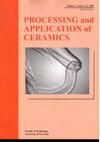Low velocity drop weight impact behaviour of Al2O3-Ni-ZrO2 and Al2O3-Ni-Cr2O3 ceramic composites
IF 0.8
4区 材料科学
Q3 MATERIALS SCIENCE, CERAMICS
引用次数: 0
Abstract
Particulate Al2O3 matrix nanocomposites containing 1 vol.%Ni were prepared by the heterogeneous precipitation method and the addition of 5 vol.% ZrO2 (ANZ) or 1 vol.% Cr2O3 (ANC). The prepared samples were subjected to the low energy drop weight impact tests to compare the behaviour of the composites under low energy impact and to investigate the damage mechanisms. The pure Al2O3, Al2O3/Ni, Al2O3/ZrO2 and Al2O3/Cr2O3 compositions with the same additive ratios were also produced to make the comparison systematically. Also, the Vickers hardness measurements were carried out and a significant increase in hardness was attained for both ANZ and ANC composites. The average hardness value around 24.8?1.0GPa was measured for the ANZ and ANC composites which means ~15% improvement compared to the pure Al2O3. Between all the compositions, the maximum force (Fmax) value was obtained for the ANZ (for 12 J impact energy level Fmax = 26617N) according to the low energy drop weight impact test results. Tensile radial crack network formation, cone formation, fracture and crushing of the cone structure were observed as damage mechanisms for all compositions. The volume of conical frustum structure was evaluated for each composition and the effect of microstructure on possible ballistic performance was also discussed.Al2O3-Ni-ZrO2和Al2O3-Ni-Cr2O3陶瓷复合材料的低速降重冲击性能
采用非均相沉淀法,分别添加5 vol.% ZrO2 (ANZ)或1 vol.% Cr2O3 (ANC)制备了含1 vol.%Ni的Al2O3颗粒基纳米复合材料。对制备的样品进行了低能落锤冲击试验,比较了复合材料在低能冲击下的性能,探讨了其损伤机理。制备了相同添加比例的纯Al2O3、Al2O3/Ni、Al2O3/ZrO2和Al2O3/Cr2O3组合物进行系统比较。此外,进行了维氏硬度测量,ANZ和ANC复合材料的硬度都有显著提高。ANZ和ANC复合材料的平均硬度值约为24.8?1.0GPa,比纯Al2O3提高了约15%。根据低能落锤冲击试验结果,得到了ANZ在12 J冲击能级下的最大力(Fmax)值(Fmax = 26617N)。所有成分的损伤机制均为径向拉伸裂纹网络的形成、锥体的形成、锥体结构的断裂和破碎。评估了每种成分的锥形截锥结构的体积,并讨论了微观结构对可能的弹道性能的影响。
本文章由计算机程序翻译,如有差异,请以英文原文为准。
求助全文
约1分钟内获得全文
求助全文
来源期刊

Processing and Application of Ceramics
MATERIALS SCIENCE, CERAMICS-
CiteScore
1.90
自引率
9.10%
发文量
14
审稿时长
10 weeks
期刊介绍:
Information not localized
 求助内容:
求助内容: 应助结果提醒方式:
应助结果提醒方式:


